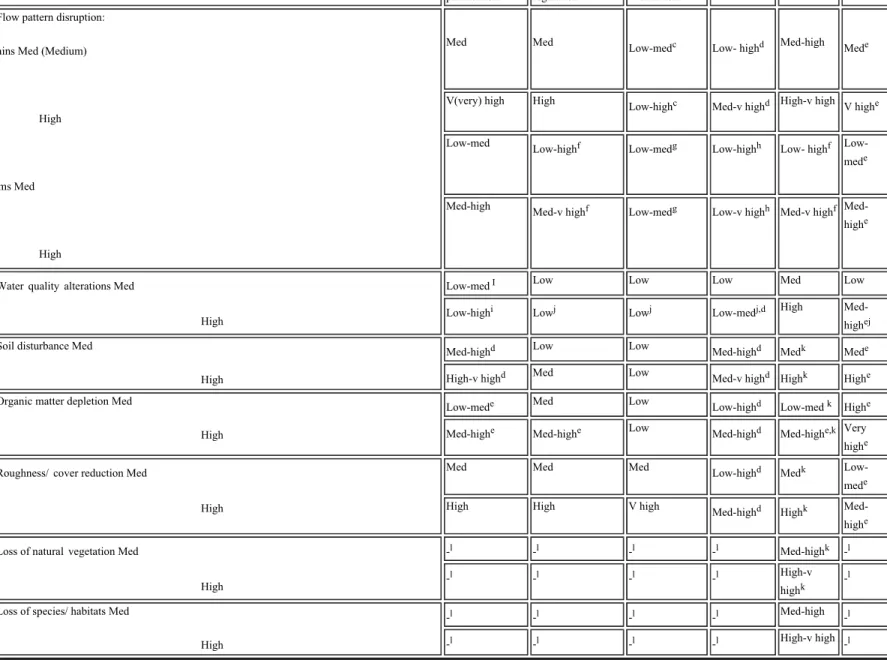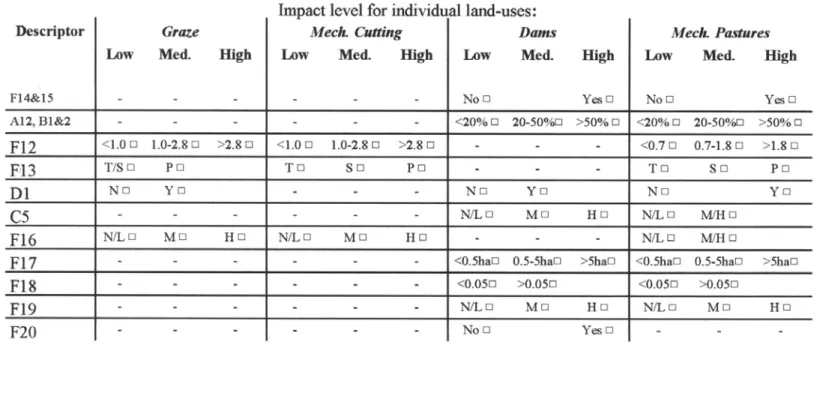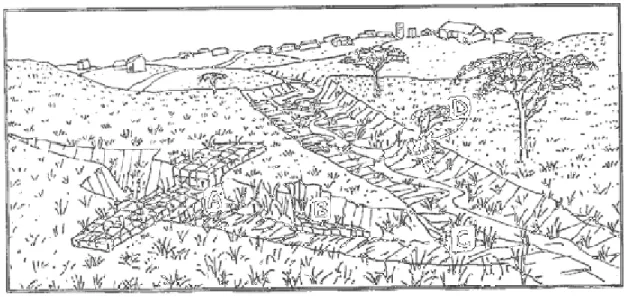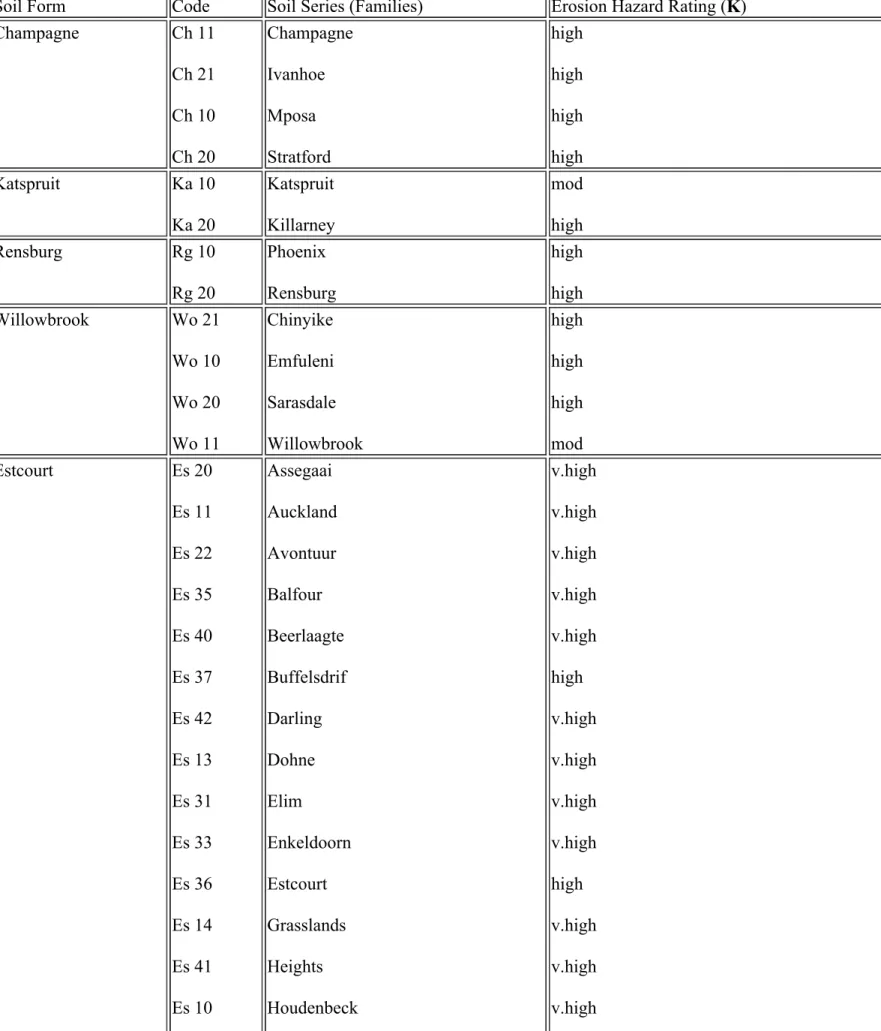WETLAND USE has two parts, the first deals with biophysical characteristics of wetlands and the second deals with the social and organizational context of the wetland. WETLAND USE Part 1 is a rapid assessment system with three main components (see cover): (1) INFORMATION-GATHERING, which guides the user in gathering useful information about the wetland and its catchment, cumulative loss context and the downstream service area; (2) IMPACT ASSESSMENT, which helps to select suitable land use alternatives for a given wetland area by predicting the likely impact of the proposed land uses on the indirect benefits of the wetland area; and (3) LAND USE RECOMMEND, which recommends how the wetland area is managed for the selected land use.
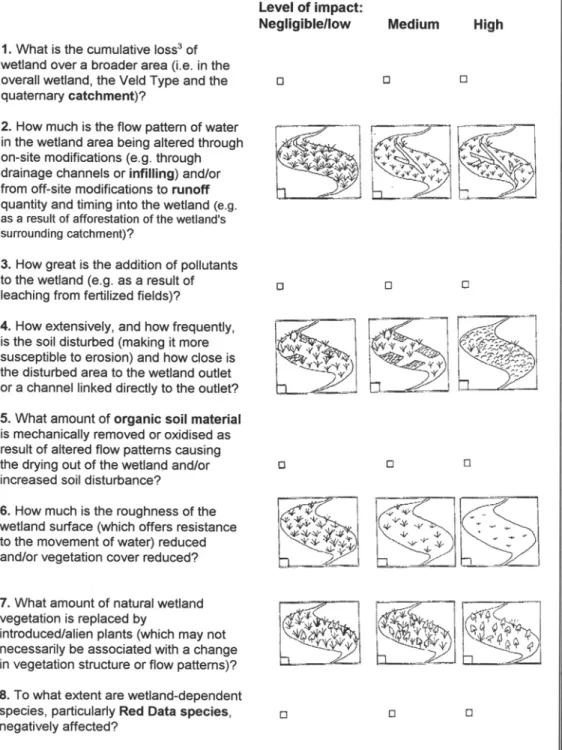
Wetness zones used by WETLAND-USE to describe the wetness of wetland areas
The extent of total loss of the Veld species (Acocks, 1953) or vegetation type (following Low and Rebelo, 1996) to which the wetland belongs. "Wetland watershed" refers to the upslope area of a wetland (from which water flows into the wetland) and includes the wetland itself.
Steps to follow in carrying out an assessment
Extent (in hectares) of the impact area that is currently untransformed (ie not drained, planted to crops or pasture, or dammed). Note: the roughness of the wetland surface slows the flow of water, which helps with erosion control and water purification. Note for A12, B1, & 2 (Cumulative loss): include the proposed area to be transformed with the existing values for A12, B1 and B2 (eg if 25% of the wetland is developed and the proposed development will add further 5% to the area developed then A12=30%).
However, if perennial grasslands were considered for the example site, the impact levels are mostly medium (ie 6 out of 10 relevant descriptors are medium) and none are high, resulting in the overall potential impact being medium.
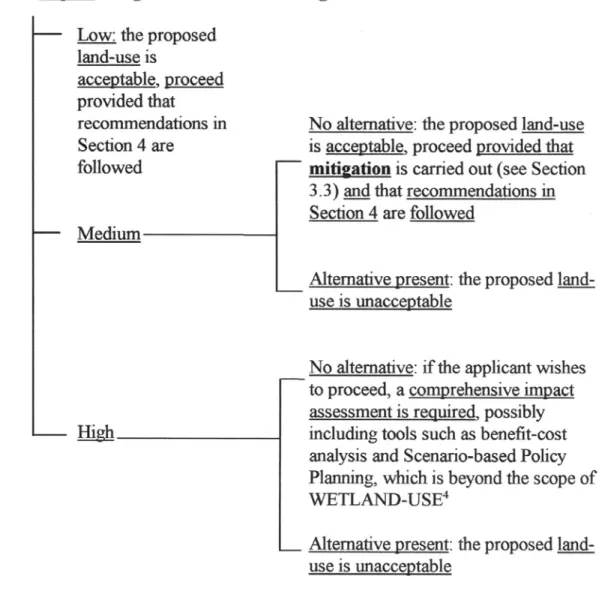
Reasoning behind the impact level criteria (see Section 5 for more detail)Box 4 Considering alternatives to the proposed project
No form of cultivation is considered acceptable in permanently wet areas because no common crops can tolerate such conditions and the hydrology would have to be changed significantly, which would detract from the hydrological and ecological values of the wetland area. Thus, if water is used for human consumption in the downstream area, the conversion of the wetland to cropland could potentially detract from this benefit. If pollutants got into a wetland, the wetland gets the opportunity to purify water.
Thus, if surface roughness is high in an untransformed wetland, then surface roughness and associated benefits are likely to be lost if any of these land uses are implemented in the wetland area.
Mitigation of impacts
If a wetland has already been transformed (e.g. if it has been artificially drained), then the loss of benefits from further transformation (e.g. damming of the drained area) in the same area is likely to be less than the would result if the area was not - transformed. From the sections below that deal with ongoing management guidance for specific land uses, continue to the section that deals with the land uses that interest you. These are not land uses per se, but may be important activities required to meet wetland management objectives.
The primary focus of WETLAND-USE is on the agricultural use of wetlands (items 1 to 6), for which comprehensive management guidelines are provided.
Management guidelines for burning 1 Positive and negative effects of burning
Recommendations about the timing and frequency of burning
- Wetlands in afforested areas
- Late winter/ early spring burning
- Infrequent burning
Early spring scalding can lead to the death of wattle-crane chicks, as the wattle-crane is a breeder from winter to early spring. Alternatively, if the chick can't be captured (which it probably will be), find where the chick is at the time of the burn and fire strategically, sometimes having to burn a break around where the chick is hiding. burning of wetlands, and of the landscape in general is the norm in South Africa's humid and sub-humid grasslands and savannas, it is believed that most wetlands in the landscape are likely to be regularly burned.
Thus, promoting the infrequent burning of some wetlands will increase the diversity of habitats provided by wetlands in the overall landscape.
Additional actions to influence fire behaviour
Wattled crane may also have started breeding at this time (see recommendations in the following section). If burning is done in late winter/early spring, it should be done approximately every second year if the rainfall is >800 mm per year or every four or five years if the rainfall is <800 mm per year. Wetlands that meet the requirements for infrequent burning should not be burned more frequently than every ten years.
Effective firebreaks are often difficult to achieve in wetlands, as fires can easily burn across the break through the loose surface litter, or even below it in the upper organic matter-rich soil layers if dry.
Management guidelines for the grazing of natural wetlands by domestic stock .1 Positive and negative effects of grazing by domestic stock
Stocking rate
If seasonal and permanently wet areas are used by livestock, only include them in the livestock calculations for the spring season, when plants in these areas are most palatable. Later in the season, plants in these areas become much less palatable and the soils are also often too wet for use. During droughts, these areas can be used as an emergency food supply and grazed for longer periods.
Example Site: falls within an area with a recommended grazing capacity in non-wetlands of 0.4AE, and 46% of Increaser II species (which according to Table 4.1 is medium condition field), and has 50 ha temporarily wet and 30 ha seasonal/ permanently wet.
Fencing of wetland areas and other means of reducing area-selective grazing
The grazing system
Management guidelines for planted pastures
- The negative effects of planted pasture and crop production
- Selection of species
- Drainage channels
- Timing of grazing
- Fertilizer application
Limitation and correct timing of the application of mineral fertilizers according to the needs of the pasture. Fertilizer applied should be just enough to meet the requirements of the specific grazing species. In newly established pastures, nitrogen from decomposed organic matter is likely to meet the initial needs of the plants.
Some of the nitrogen from the legume is made available to the grass via excrement.
Management guidelines for crop production
Once the soil approaches saturation, the irrigation system should be moved or shut down until the soil has dried out sufficiently to require irrigation again.
Management guidelines for the cutting of natural wetland vegetation for hay, crafts and construction
If the wetland is not used for grazing, this value can be increased to 50%. In wetlands where removal of leaf material is limited by other factors (eg, grazing and fire), mowing can enhance the habitat benefits provided by the wetland. The use of harvested wetland plants can also be particularly useful in providing material for poor rural people to generate income (see Box 5).
Box 5 Handicraft production from wetland plants as a low impact use of wetlands for promoting rural development.
Management guidelines for dams, weirs and water extraction
For more information contact your provincial department of environmental affairs and the National Department of Water Affairs.
Rehabilitation of wetlands
Alien plant control
Always remember to perform follow-up treatments. Many people fail to do this, which allows the alien plants to grow back and is a waste of initial effort and money spent. Effective control of alien plants must be well coordinated and responsibilities for carrying out the various actions must be clearly defined.
Spring protection
Infilling
Mining (excavation)
Roads, including bridges and culverts
Adequate culverts are required to minimize impact on water flow patterns through the wetland.
Infrastructure
Ecotourism
All other infrastructure and roads should be located outside the wetland or other sensitive natural areas. Usually, one of the main attractions of wetlands for tourists is the bird-watching opportunities that the wetland provides. Most of the wetland is owned by Wakkerstroom municipality and leased for grazing, which, along with ecotourism, is one of the main direct uses of the wetland.
The town now has several guest houses and bed and breakfast facilities, and the wetland and associated birdlife are one of the main attractions for visiting tourists.
Hunting and fishing
Harvesting of medicinal plants
Forestry and sugar cane plantations
Planting sugarcane in wetlands is not generally considered acceptable, especially where drainage ditches are used because of the impact on the hydrological benefits of wetlands. Both forest and sugarcane plantations within wetlands also greatly reduce the value of the habitat that wetlands provide for wetland-dependent species. Under the Forestry Act, forest plantations in wetlands are not considered acceptable due to the trees' high water use.
Forest plantations within wetlands often have high alien plant infestations (see Section 4.8) which further contribute to the impact of afforestation in wetlands.
Wastewater treatment
However, if sugarcane plantations legally in wetlands are to be retained, see recommendations for planted pastures (Section 4.3). Regulations governing plantations and wetlands are contained in the Forests Act, and for further information on forest management see "Guidelines for Environmental Conservation Management in Commercial Forests in South Africa" by the Forest Industry Environmental Committee (1995). For further information on the effectiveness of wetlands in treating wastewater and in predicting the likely impacts of wastewater on contact with wetlands: A Batchelor, CSIR et al. N Kleynhans, Institute for Water Quality Studies, Department of Water Affairs and Forestry (DWAF.
For information on the legal aspects of wastewater treatment contact your DWAF regional office http://www-dwaf.pwv.gov.za).
Solid waste (litter)
Accumulating sediment can alter the flow patterns in the wetland, reducing the extent of diffuse flow. In addition, other pollutants attached to the sediment will be brought in with the sediment. Most of these substances affect the physiological functioning of plants and animals and can have extremely serious impacts.
These heavy metals remain in the sediment indefinitely and can be released back into the water in response to a change in pH.
Water-associated parasitic disease control
The ability of different plant species to respond to enriched nutrients varies, with the result that the species composition can change drastically and eventually include a few dominant species, such as Typha latifolia, that have a high ability to respond. The increased plant production can result in increased decaying plant material, which would increase the biological oxygen demand (BOD), and this in turn can have serious consequences for aquatic organisms. Increased acidity can also cause toxic effects from certain metals such as mercury, which under acidic conditions are soluble and extremely toxic to wetland biota.
Biocides specifically target organisms and it is therefore inevitable that wetland biota will be adversely affected.
Primary assumptions of IMPACT-ASSESS
Assumptions concerning the erosion hazard index and individual land-uses
Ecological value: the value of wetlands in maintaining the biotic diversity of the area. Impact site: that part of the wetland area in which a proposed land use will be implemented. Land poaching should be avoided because, in addition to reducing plant production, it also significantly increases the soil's susceptibility to erosion.
Soil Drainage Classes: Describe soil moisture conditions determined by soil capacity and site for disposal of excess water. Most of the roots of herbaceous plants are located in this upper 0.5 m of soil. Soil forms in the second group (typically hydric) are commonly found in wetlands, depending on the depth of wetness-related features and the intensity of wetness indicators (eg, the soft gas horizon varies with the intensity of wetness indicators within the profile).
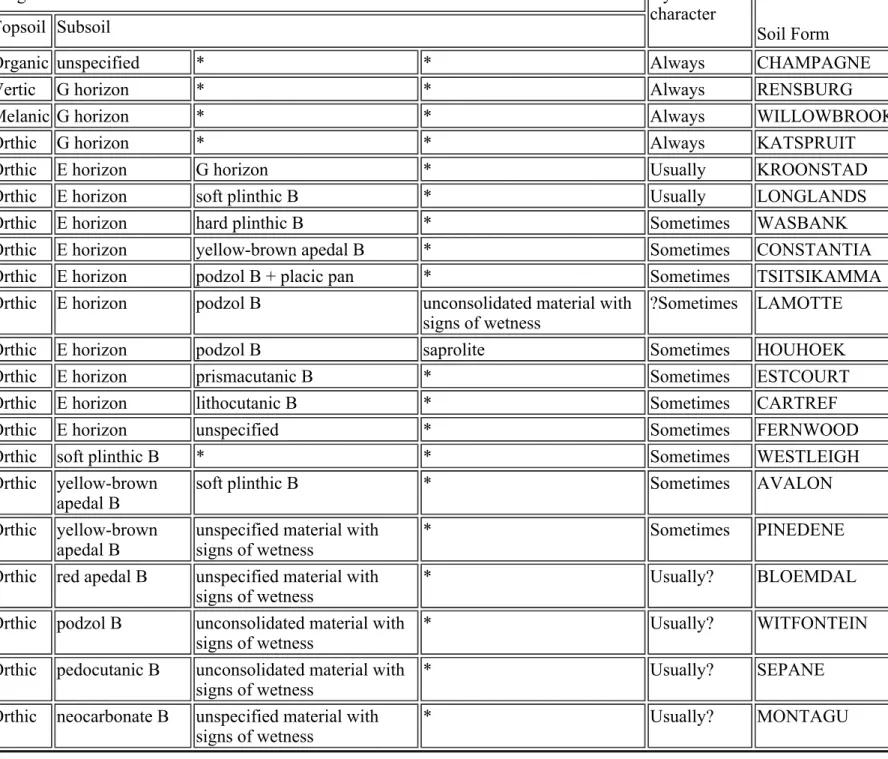
ADDITIONAL DESCRIPTORS FOR DESCRIBING THE WETLAND AND ITS CONTEXT A20. Terrain unit/s (according to Land Type survey Staff [1986]) on which the wetland occurs
Note: To calculate the average width of the wetland, divide the wetland (perpendicular to the flow direction) into 5 segments of equal length and measure the width of each segment (centered and perpendicular to the flow direction). calculate their average by dividing their sum by 5. If the wetland were curved or twisted, the length of the wetland would be longer than the straight-line distance from the inlet to the outlet. Note that the wetland may only be important for a few weeks a year or even less often, but it remains important nonetheless.
A31 Indicate (Y or N) whether the wetland is part of and essential to an ongoing long-term environmental research/monitoring program.
